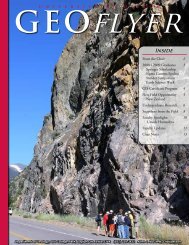Stander Symposium abstract book - University of Dayton
Stander Symposium abstract book - University of Dayton
Stander Symposium abstract book - University of Dayton
You also want an ePaper? Increase the reach of your titles
YUMPU automatically turns print PDFs into web optimized ePapers that Google loves.
POSTER SESSION 1<br />
question-by-question analysis <strong>of</strong> each participants’ responses was completed. Results indicate that most <strong>of</strong> the participants had good experiences<br />
in high school and college, in general, but their responses varied greatly in how they viewed those experiences.<br />
Numerical Algorithm to Value American Call Option<br />
Presenter(s): Junyao Zhang<br />
Advisor(s): Paul W Eloe<br />
Mathematics - Graduate Research<br />
A numerical algorithm is developed to produce a numerical solution <strong>of</strong> a boundary value problem for the Black-Scholes partial differential equation<br />
on a certain region that includes a free boundary. In this algorithm, an artificial boundary is introduced and a method to find the free boundary<br />
is developed. This algorithm is introduced by H. Han and X.Wu, A Fast Numerical Method for the Black-Scholes Equation <strong>of</strong> American Option,<br />
SIAM J. Numer. Anal., 41 (2003), pp. 2081-2095.<br />
Numerical Investigation into a Computational Approximation <strong>of</strong> Bifurcation Curves<br />
Presenter(s): Joshua R Craven<br />
Advisor(s): Muhammad Usman<br />
Mathematics - Independent Research<br />
In this project, I use computational tools to study the bifurcations in nonlinear oscillators. Matlab is first used to determine the slow flow phase<br />
portrait <strong>of</strong> each region and the characteristics <strong>of</strong> each critical point. Next, the parameters are discretized and for each set <strong>of</strong> values we find the<br />
locations <strong>of</strong> the real critical points and the eigenvalues <strong>of</strong> the Jacobian matrix. With this knowledge, we can approximate the bifurcation diagram.<br />
These results are compared with results from preexisting s<strong>of</strong>tware.<br />
Option pricing based on Regime-Switching Recombining Tree<br />
Presenter(s): Tao Tian<br />
Advisor(s): Paul W Eloe<br />
Mathematics - Graduate Research<br />
Our goal is to design an efficient Regime-Switching recombining tree (RS-tree) to calculate the option price based on the condition that the underlying<br />
stock price fits the regime-switching model. The RS-tree is efficient if it grows linearly as the time steps increases; as a result, we can use<br />
many more time steps to calculate the option price. Both European and American options will be calculated in this Regime-Switching model. The<br />
next step is to design the RS-tree to two regimes (here m=2), and use the Regime-Switch model to calculate the option price for both European<br />
and American option. Finally, we will compared the result with others method. II.MethodAt first, we extend the Cox, Ross and Rubinstein Tree<br />
for the Black-Scholes-Merton option pricing model. Then we employ the method developed by Liu to construct an efficient RS-tree for European<br />
and American options. We begin with a 2-regime model. For the Transfer probability based on the two regimes, we use the method from Yin and<br />
Zhang. We construct a RS-tree which grows linearly and accomplish this by a recombination <strong>of</strong> nodes at each time step. As a result, we adjust<br />
the up factor U in a reasonable way; also, it is necessary to match the local mean and variance calculated from the tree to that implied by the<br />
continuous regime-switching diffusion in order for the discrete tree approximation to converge to the continuous process as the time step h goes<br />
to zero. Upon successful development <strong>of</strong> the 2-regime algorithm, we shall extend the algorithm to m >2 regimes and extend the applications to<br />
exotic options in the future.<br />
Road Travel Time Estimation with GPS Floating Car Data<br />
Presenter(s): Jieai Zheng<br />
Advisor(s): Ruihua Liu<br />
Mathematics - Graduate Research<br />
The objective <strong>of</strong> this research is to provide reliable estimation <strong>of</strong> urban roadway travel time in time for traffic managing departments and travelers<br />
based on floating car data. Travel time data collection and estimation is an important technology method to achieve the Intelligent Transportation<br />
Systems (ITS) information services. Poor-quality information leads mistrust and un-ease <strong>of</strong> traffic congestion. Thus the accuracy <strong>of</strong> travel<br />
time prediction must meet certain requirements. GPS floating car collection method accesses the data source by ordinary vehicles equipped with<br />
41

















